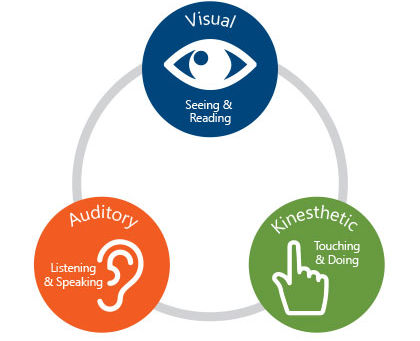



Visual, Auditory, or Kinesthetic?
Being able to decipher what kind of learning style your customer has could mean the difference between a satisfying transaction for both parties, and a stalemate full of miscommunications.
Three widely accepted learning styles are visual, auditory, and kinesthetic. First, we’ll look at what each of those mean. After that, we’ll look at how to tell what style your customer is. Lastly, we’ll dig into ways to appeal to these natural tendencies that all of us have.
Who Are They?
Visual Learners
Visual learners learn best by taking in information with their eyes. They are often the “seeing is believing” type of person, and they assign much more credibility to facts and information in writing or images than they do to just hearing someone tell them alone.
Auditory Learners
Auditory learners learn best by hearing information. They are in a way the inverse of the visual learners. They prefer to have someone explain how something works, or listen to a recording or a video. They are generally going to assign much more attention and value to when someone is talking, and really focus on the point they are making.
Kinesthetic Learners
Kinesthetic or tactile learners are the doers. They like to get their hands dirty and give whatever they’ve got in front of them a try to really cement the learning. Often tactile learners will toss the instruction card out and just dive in when assembling new piece of furniture. They’re brains make better connections when they can actually experience what they are trying to learn.
Not everyone is a clear cut one specific style. Many individuals overlap and can benefit from receiving information in all three methods. However, most of the time, there is a preferred method, and if you can identify it, then you will be able to better relay the information in a manner that will be well received.
How do You Tell?
Visual Learners
You can often identify a visual learner by their interest in the signage around your dealership. If they mention something they read on either a sign, a sell sheet from one of the units, or maybe an add they read in the paper or online, that is often an indicator of a visual learner. They will also say statements like “I see what you’re saying” or “let me see your best offer”.
Auditory Learners
These individuals are going to be much more receptive to the sounds going on around them. They will request you to tell them, rather than show them information and use phrases like “I hear what you’re saying”. They are open to hearing a pitch and usually listen very attentively.
Kinesthetic Learners
These are identified by their behavior on the lot. If they are poking and prodding the unit, or testing out the movable features, that is a good indicator of a kinesthetic learner. If they immediately grab for something to fiddle with when they are sitting down that is often a sign that they learn by feeling and touching. They may say phrases like “I’m feeling pretty good about this” or “I feel as though you can do better”.
Once you’ve identified what kind of learner your customer is, what do you do with that information? There are a number of methods to provide the individual with the information using the delivery method that they most prefer and will most effectively absorb.
What Do You Do?
Visual Learners
They respond to things they see so give them plenty of things to look at. Utilize menus, placemats, and brochures. Focus on the less wordy parts and more on the images and the short and pithy statements that get the point across quickly. While you’re doing your pitch, make sure you’re giving them something to look at while you talk, otherwise you risk losing their attention to one of the million other things hanging or sitting around the finance office. If you can incorporate images into your customer communication with visual learners, then they will be better able to absorb and retain what you tell them and then make an informed decision.
Auditory Learners
They like to be told, so tell them. Make sure you don’t overly distract them with props or visual. Some are fine to drive home your points, but the majority of the information should be relayed either by speaking or in some cases a prerecorded message or video. The conversation is key with auditory learners, so make sure you don’t skip over any information or assume that they read anything on one of your marketing materials.
Kinesthetic Learners
Remember, these are the doers. They want to experience what you’re telling them. A great way to appeal to these learners, is to have props for them to play with and touch while you’re in the business office. A blown-out control module is not a cheap fix and having one on your desk to highlight “this tiny thing costs $2,500 to replace!” while the customer is holding it in their hands, can really drive your point home. The more often you can get something in a kinesthetic learner’s hands the better.
Knowing how best your customer learns can take your existing pitch and increase its effectiveness even more. It will help the customer have a better experience, and at the end of the day, the whole process will go more smoothly. It also pays to know what your learning style is so that you can not only know how you best learn, but so you can also relate to where you customer is coming from. Below is a link to a short VAK Learning Style quiz. Feel free to take it and post in the comments section what your results are!
https://www.proprofs.com/quiz-school/story.php?title=vak-quiz-visual-auditory-kinesthetic